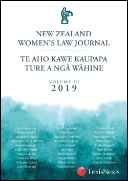SAFETYLIT WEEKLY UPDATE
SafetyLit Journal DetailsWe are unable to provide photocopies of any the articles and reports abstracted in SafetyLit updates. Where possible, links have been provided to the publisher of the material and contact information for the corresponding author is listed. Please consider asking your library to subscribe to the journals from which these abstracts have been gathered. |
|
New Zealand women’s law journalTe Aho Kawe Kaupapa Ture a ngā Wāhine Abbreviation: N Z Women. Law J.Published by: Trustees of the New Zealand Women's Law Journal Publisher Location: Wellington, New Zealand Journal Website:
Publication Date Range: 2017 -- Number of articles from this journal included in the SafetyLit database:
1 pISSN = 2537-9658
Journal Language(s): English
|
|
